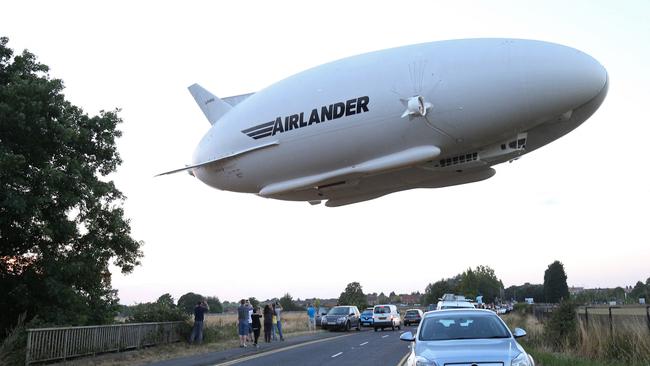Hybrid Airlander may finally be given the green light to take off
The odd-looking hybrid aircraft Airlander could carry 100 passengers while remaining remarkably fuel efficient.

It has cost about £140m ($275m), has endured a crash landing, project delays and warnings from its auditors about its financial footing, but a UK government-backed company developing one of the world’s largest aircraft is close to bringing its design into production.
The Airlander 10, a hybrid of a plane and an airship designed to be the world’s most efficient large aircraft, could be in service by 2029, including regional air travel in Europe and tourism expeditions in the Arctic.
A factory in Doncaster, in England’s north, has been lined up to produce 24 Airlanders a year, which would create 1200 jobs and produce annual sales of about £1.2bn a year for Hybrid Air Vehicles, the company behind a project it hopes will “transform what aircraft can do”.
First, though, there is the small matter of raising tens of millions of pounds more to keep HAV in business: it expects it will need a further £300m over the next few years to break even.
“We’re done prototyping. The next step is multiple aircraft going through production,” HAV chief executive Tom Grundy says. “The sort of thing air taxis are going through now, we’ve put behind us.”
The Airlander 10, nicknamed the “flying bum” owing to its distinctive posterior, is intended to be a low-emission aircraft with more than 100 seats.
The craft, which emerged from an abandoned US military surveillance project, is capable of carrying more than 10 tonnes for logistics purposes, is able to stay airborne for more than five days, and can land on “fields, tarmac or sea”, so does not need traditional airport infrastructure.
The Airlander is the first new large aircraft to go through the Civil Aviation Authority type certification process since 1979: a “big milestone” for a “big and unusual project”, Grundy says.
About $3bn of the aircraft are on order, including by Spanish company Air Nostrum, one of Europe’s largest regional airlines.
A consortium is also exploring using the Airlander for passenger and freight transport in the Scottish Highlands and Islands, and there are expected to be logistics and military applications as well.
Grundy, 47, says the fuel-efficient aircraft were compelling for an industry under pressure to reduce its enormous carbon footprint.
“We’ve got a path to taking 75 to 90 per cent of the emissions out of flying,” he says. “There’s nothing else out there that can do that so imminently.”
With a top speed of 130km/h, which is comparable with trains and a little slower than commercial helicopters, Airlanders are not going to be replacing airliners on flights to New York or Australia, but an alternative to jets for domestic air travel is a viable option, Grundy argues. “Industries have to start somewhere. (Our customers can) set leadership.”
Unlike airships, which people associate with famous disasters and which declined as aeroplanes came to dominate air travel, Airlander relies on a combination of aerodynamic lift and engine power for takeoff and landing (like a plane), and buoyant lift provided by helium (like an airship).
“There have been years of trying and failing to make airships work commercially,” Grundy says. “Helium brings all sorts of problems and means an airship needs to be really big because it takes a lot of volume to do the job. Our platform can be smaller, and smaller generally means cheaper, so we can address different markets. Uniquely for a green technology, we are coming in without needing to charge a green premium.”
As it becomes less acceptable to use emission-intensive aircraft on very short flights, Airlander can step in, Grundy says. HAV says it reduces emissions by up to 90 per cent when compared with traditional aircraft on similar trips.
On entry to service it will be powered by traditional aircraft fuel, with an all-electric Airlander powered by hydrogen fuel cells planned for 2030.
Overall travel times for most domestic Airlander journeys will be comparable to taking a plane, Grundy argues, because of the time savings of avoiding traditional airport infrastructure. The ability to operate on water means it could take off and land near city centres, for example.
“In a lot of cases you’d be using rail if you could, but perhaps there’s water in the way. Airlander can use airports but doesn’t have to. You don’t need big terminals.”
In military applications such as surveillance, and potential cost savings are also producing strong interest, and HAV is consulting on projects with the US Department of Defence.
In logistics, meanwhile, a future, larger iteration of Airlander able to carry more than 50 tonnes could find a market between energy-intensive airfreight on one side and slow shipping on the other.
Grundy, a former senior engineer at BAE Systems and Airbus, hopes that by 2027 the company should be completing test flights of aircraft and that by 2029 Airlander will be flying paying passengers.
Caution should be applied to such projections: five years ago, Grundy suggested that Airlander city connector services could be “in service in 2025”.
“We are not yet running at the pace we want to run,” he admits. “Dates have been slipping a bit.”
Airlander hit the headlines in 2016 after the aircraft was damaged when it nosedived on landing during its second test flight, causing significant damage to the cockpit, and the following year, when a prototype broke free from a mooring mast.
It has since completed numerous successful test flights and the design has been refined.
“It’s very clear to me that this project is strategically important, a product that has environmental and economic benefits, provides jobs and revenues,” Grundy says. “We are in a global competitive space.”
THE TIMES





To join the conversation, please log in. Don't have an account? Register
Join the conversation, you are commenting as Logout